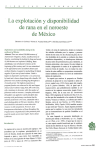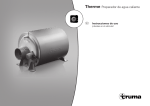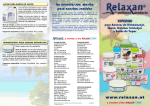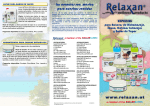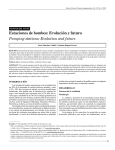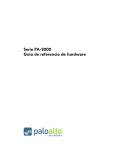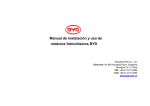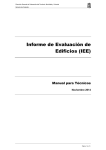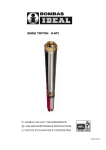Download Descargar Manual de Uso y Mantenimiento SVA con ressistencias
Transcript
SVA INSTALACIÓN, MONTAJE Y MANTENIMIENTO INSTALLATION, ASSEMBLY AND MAINTENANCE Bombas Ideal, S.A. 2 INDICE INDEX PAGINA 1. 2. 3. 4. 5. 6. 7. 8. 9. PREÁMBULO – GARANTIA....................................................................................... RECEPCIÓN ............................................................................................................. DESCRIPCIÓN DEL GRUPO ……………………………………………………………. CONEXIONADO ELÉCTRICO .................................................................................. CONTROL Y MANTENIMIENTO .............................................................................. ANOMALIAS DE FUNCIONAMIENTO ...................................................................... SECCIÓN Y LISTA DE COMPONENTES ................................................................. DIAGRAMA CONEXION ........................................................................................... INSTALACION TIPO .................................................................................................. 3 3 3 4 4 5 9 10 11 PAGINA 1. 2. 3. 4. 5. 6. 7. 8. 9. INTRODUCTION AND WARRANTY ......................................................................... ACCEPTANCE .......................................................................................................... GROUP DESCRIPTION ............…………………………………………………………. ELECTRIC CONNECTIONS ..................................................................................... CONTROL AND MAINTENANCE ............................................................................. TROUBLESHOOTING …………............................................................................... SECTION AND COMPONENTS LIST …................................................................... CONEXION DIAGRAM ............................................................................................... INSTALLATIONS TYPE............................................................................................... 6 6 6 7 7 8 9 10 11 Bombas Ideal, S.A. 1. PREAMBULO – GARANTIA Este manual de servicio está dirigido a los usuarios de bombas SVA. Contiene las instrucciones de instalación, servicio y mantenimiento. Antes de proceder a cualquier tipo de intervención, el usuario debe leer atentamente este manual y prestar atención a cuantas sugerencias y recomendaciones se den en él, especialmente las que sean precedidas de los siguientes símbolos de seguridad: La no observancia de estas instrucciones, puede exponer a las personas a riesgos importantes para su salud. La no observancia de estas instrucciones, puede exponer a las personas a riesgos de origen eléctrico. ATENCIÓN Las instrucciones identificadas con este mensaje, indican su importancia para una correcta instalación, utilización y mantenimiento. Las instrucciones contenidas en este manual cumplen con la Directiva de la CEE sobre Máquinas nº89/399, así como sus sucesivas modificaciones. Con el objeto de mejorar el resultado final de sus productos, Bombas Ideal S.A. se reserva el derecho de modificar el contenido del presente manual y/o el propio producto sin necesidad de avisar previamente a sus clientes. El incumplimiento de las sugerencias y recomendaciones de este manual, así como la incorrecta utilización o la manipulación no autorizada del producto, invalida totalmente la responsabilidad de Bombas Ideal S.A., por los posibles daños causados, ya sean personales o materiales. Ante cualquier duda respecto del producto, su utilización, mantenimiento o reparación deberán contactar con; Bombas Ideal S.A. Polig. Ind. Mediterráneo C/Cid nº 8 Tfno. 34 961 402 143 Fax 34 961 402 131 46560 Massalfassar – Valencia – Spain El manual se suministra junto con la bomba y debe estar próximo al lugar de la instalación, debidamente protegido, para que pueda ser consultado por los usuarios en caso de necesidad. 2. RECEPCIÓN En el momento de la recepción del material que compone la expedición se comprobará si los materiales han sufrido algún desperfecto, en especial el cable de alimentación. Hacer recuento de los mismos y notificar la existencia de cualquier anomalía. Si el grupo debe permanecer algún tiempo en almacén convendrá colocarlo en un lugar seco. Después de un largo período de inactividad, tanto en almacén como en el lugar de trabajo, girar el rodete a mano, por si hubiera algún proceso de agarrotamiento por oxidación. 3 Bombas Ideal, S.A. 4 3. DESCRIPCION DEL GRUPO Las bombas sumergidas SVA con rodete de hélice están especialmente diseñadas para elevar grandes caudales de agua. Se emplean ventajosamente en el bombeo de aguas pluviales, estaciones depuradoras, desecación de terrenos, riegos, arrozales, drenajes, refrigeración de centrales eléctricas, etc. Los altos rendimientos obtenidos por este tipo de bombas las hacen recomendadas para estas instalaciones. Es importante respetar los límites de funcionamiento siguientes: Máxima temperatura del agua 40ºC PH: 5-9 Máxima sumergencia: 10 mts. Las bombas SVA son de construcción robusta y compacta de eje único entre motor y bomba, dando una solidez al conjunto que elimina problemas de instalación. Han sido diseñadas para su instalación en posición vertical. El montaje resulta sencillo, al ir fijada por su propio peso e instalada dentro de un tubo de descarga o en cámara de obra civil de hormigón. El motor, totalmente sumergido, forma una unidad compacta con la parte hidráulica. Es trifásico, con protección IP 68 y aislamiento clase F, para 155º C. El eje del rotor gira sobre cojinetes de bolas lubricados permanentemente, libre de mantenimiento. La estanqueidad del eje entre el motor y la parte hidráulica se consigue por medio de dos cierres mecánicos de alta calidad y una cámara de aceite intermedia. Se incorporan en el grupo funciones de control: - Control temperatura del bobinado Detector humedad en estator Detector humedad en caja conexiones Detector de humedad en la cámara del aceite El esquema de conexión se muestra en el apartado 8. 4. CONEXIONADO ELECTRICO Antes de la puesta en marcha se deberá comprobar los siguientes puntos: a) Que la tensión de la red corresponde a la indicada en la placa del grupo. b) En caso de arranque directo según los siguientes esquemas. Z X Y Z X Y U V W U V W FIG. 1 Bobinado 230/400 red 230V Bobinado 400/690 red 400V FIG. 2 Bobinado 230/400 red 400V Bombas Ideal, S.A. c) En el caso de arranque estrella - triángulo, del motor salen 2 cables que habrá que conectar adecuadamente al cuadro de maniobras. d) En todos los casos se conectará el cable de toma de tierra para evitar accidentes. e) Control de temperatura del estator: El sensor térmico que lleva el bobinado incorporado protege el estator de sobrecalentamiento en casos como prolongado funcionamiento en seco, excesiva temperatura en el medio bombeado, etc. f) Detección de humedad. En la cámara del aceite, caja de conexiones e interior motor se coloca un electrodo que asegura la estanqueidad, detectando la presencia de humedad. La resistividad normal es ≥ 100 KΩ, en caso de entrada agua o humedad, la resistividad cae hasta ser ≤ 30KΩ g) Control de temperatura de los rodamientos (opcional): Los sensores térmicos de los rodamientos los protegen ante sobrecalentamiento en casos como falta de lubricación, rodamientos dañados, excesiva temperatura en el medio bombeado, etc. Convendrá asegurarse que los fusibles o relé de sobrecorriente montados y regulados son los adecuados para soportar la carga de arranque. Se verificará el sentido de giro del grupo, cambiando las fases de conexión en el cuadro en caso de que lo haga en sentido contrario. 5. CONTROL Y MANTENIMIENTO El funcionamiento del grupo debe ser silencioso y sin vibraciones. Se observará en los amperímetros del cuadro eléctrico cualquier consumo anormal y en caso de que así sea se buscarán las posibles causas. El número máximo de arranques por hora es de 6. Si el grupo se para y al intentar ponerlo en marcha la protección se dispara es conveniente no insistir, averiguar las causas y subsanarlas adecuadamente, pero nunca forzar al grupo a trabajar en tales condiciones. El mantenimiento de los grupos SVA es prácticamente nulo, salen de fábrica perfectamente preparados para su inmediata utilización sin necesidad de manipulación. No obstante para asegurar una larga duración de la bomba se recomienda comprobaciones e inspecciones regulares. Será importante observar el estado de las juntas tóricas, pues como elementos de cierre estático deben estar en perfectas condiciones. Al menor indicio de defecto deben ser sustituidas. Si se observara disminución en la cantidad de aceite o presencia de agua se procederá a la revisión de los cierres mecánicos para comprobar su estanqueidad. Una vez comprobado se repondrá el aceite que deberá tener una viscosidad entre 3 y 6 grados Engler a 50º C, equivalente a un SAE 10 - 20. 5 Bombas Ideal, S.A. 6 6. ANOMALÍAS DE FUNCIONAMIENTO ANOMALIA 1. El grupo no arranca. CAUSA 1.1 No hay tensión en la red. 1.2 Fusible fundido. 1.3 Cable cortado. 1.4 Bomba agarrotada. 2. El grupo arranca pero no 2.1 Giro contrario. eleva agua. 2.2 Altura real mayor que la de la bomba. 2.3 Rodete atascado. 3. Caudal insuficiente. 3.1 Giro contrario. 3.2 Tubo descarga obstruido. 3.3 Rodete parcialmente atascado. 3.4 Desgaste de rodete. 4. Intensidad absorbida 4.1 Bomba frenada. superior a la prevista. 4.2 Tensión red baja. 4.3 Tensión de red inferior a la indicada en la placa. 5. Agua en la caja de 5.1 Juntas deterioradas. conexiones motor. 5.2 Rotura del recubrimiento del cable. 6. Agua o aceite en la carcasa 6.1 Cierre mecánico superior del motor. deteriorado. 6.2 Juntas tóricas carcasa estropeadas. 7.Agua en el aceite del 7.1 Cierre mecánico inferior depósito. deteriorado. 7.2 Tapones de llenado y vaciado mal apretados o juntas rotas. 7.3 Juntas tóricas estropeadas. SOLUCION 1.1 Averiguar si hay fluido. 1.2 Reponer fusible. 1.3 Reparar cable. 1.4 Soltar bomba. 2.1 Invertir el giro. 2.2 Cambiar el tamaño bomba. 2.3 Desatascar el rodete. 3.1 Invertir el giro. 3.2 Limpiar tubo. 3.3 Limpiar rodete. 3.4 Cambiar rodete. 4.1 Soltar la bomba. 4.2 Elevar la tensión en red. 4.3 Cambio del tipo de grupo. 5.1 Reponer juntas. 5.2 Reparar cable o cambio por uno nuevo. 6.1 Cambiar cierre mecánico. 6.2 Poner juntas nuevas (reponer aceite). 7.1 Cambiar cierre mecánico. 7.2 Apretar tapones y cambiar juntas. 7.3 Poner juntas nuevas (reponer aceite). Bombas Ideal, S.A. 1. INTRODUCTION AND WARRANTY This service manual is intended for users of SVA pumps. It contains the instructions for installation, service and maintenance. Before proceeding to do any kind of work on the equipment, users should read this manual carefully and pay attention to any suggestions and tips given in it, particularly the ones preceded by the following safety symbols: Failure to observe these instructions may expose people to serious danger for their health. Failure to observe these instructions may expose people to electrical risks. TAKE NOTE Any instructions preceded by this message are of great importance for proper installation, use and maintenance. The instructions contained in this manual comply with EEC directive nº89/399 on machines, as well as its subsequent modifications. In order to improve the final result of its products, Bombas Ideal S.A. reserves the right to modify the content of this manual and/or the product itself with no need to inform its customers beforehand. Failure to comply with the suggestions and recommendations in this manual, as well as improper use or non-authorised handling of the product, shall fully release Bombas Ideal S.A. from any liability as regards possible damage caused, whether this be personal or material. In the event of any doubt about the product, its use, maintenance or repair, please contact; Bombas Ideal S.A. Polig. Ind. Mediterráneo C/Cid nº 8 Tel. 34 961 402 143 Fax 34 961 402 131 46560 Massalfassar – Valencia – Spain The manual is supplied along with the pump and should be kept close to the point of installation, duly protected so that this can be consulted by users when required. 2. ACCEPTANCE Check that the packing and shipping materials have not been damaged in transit, specially the inlet cable. Make a report of any such damage and notify any irregularities at once. If the pump is to be stored for any length of time, it must be kept in a dry place. The impeller of the pump must be rotated by hand after a long period of being out of active service, to detect seizing due to oxidation. 7 Bombas Ideal, S.A. 8 3. GROUP DESCRIPTION The SVA submersible pumps, provided with propeller/helicoidal impeller, are expressly designed for lifting considerable flow rate capacities. They are extremely suitable for pumping rainfall deposits, purifying stations, ground drying, irrigations, rice fields, waste drains, power plant cooling systems, etc. Thanks to the high efficiencies obtained by this kind of pump, they are particularly recommended for the above plants. It’s important to observe the following operational limits: Maximum water temperature 40ºC. PH: 5-9 Maximum submergence depth : 10 mts. The SVA pumps have strong and compact structure and are provided with single motor – pump shaft, thus giving a very solid unit with easy installation. SVA pumps have been designed for vertical installation. The erection is quite simple, as the pump is fixed by its own weight and installed inside a waste piping or in a concrete civil work chamber. The submersible motor makes a compact unit with the hydraulic part. It is three phase, have IP68 protection and Class F insulation for use up to 155º C. The rotor shaft rotates on free-maintenance ball bearings permanently lubricated. A set of high quality mechanical seals, operating in an oil bath and situated between the pump and the motor, brings about complete leak-tightness. Following control functions are incorporated in the unit: - Winding control temperature. - Humidity sensor on stator - Humidity sensor on connexion box - Humidity sensor on oil bath. The connexion diagram is showed in chapter 8. 4. ELECTRIC CONNECTIONS Prior to starting the following points shall be duly verified: a) The mains voltage is exactly the same as that stated on the group plate. b) In case of a direct start, as show in the figs. 1 and 2 Z X Y Z X Y U V W U V W FIG. 1 Winding 230/400 network 230V Winding 400/69 0 network 400V FIG. 2 Winding 230/400 network 400V Bombas Ideal, S.A. c) In case of a star-delta start, there are two cables leaving the motor which shall appropriately connect to the control panel. d) In every case the ground connection shall be connected in order to avoid any undue accidents. e) Temperature control in the stator: the stator is protected by a thermal sensor incorporated in the motor to protect against overheating due to dry running, high temperature in the fluid, etc. f) Humidity sensor: On the oil bath, connexion box, and motor chamber one electrode is placed to control the leak-tightness. Normal resistivity is ≥100 KΩ, in case of water entrance or humidity, the resistivity drops down to ≤ 30KΩ. g) Temperature control in ball bearings (under request): Ball bearings thermal gauges protect against overheating due to loss of grease, bearing damage, high temperature in the fluid, etc. h) It shall be verified whether the fuses and relays of overcurrent mounted and adjusted are the appropriate ones to stand the starting load. The sense of rotation must be verified too. Phase sequence will be changed if requested. 5. CONTROL AND MAINTENANCE The group performance must be in a noiseless and vibration-free manner. The ammeters on the electric panel shall be verified for any abnormally high consumption and if this proves to be the case, any eventual reasons shall be found out. The maximum number of starts per hour is six. If the group stops and the its protection blows out when an attempt to put it back to service is made, you shall not insist at all but just find out the reasons and overcome them in the best possible manner as it is not good to force the group into operating in such conditions. The SVA groups call for practically no maintenance. They leave our plant ready for immediate utilization without any previous manipulation. Nevertheless, inspections shall be carried out regularly to warranty a perfect work. Another important point to keep in mind here is the status of the relevant O’rings since as they are static sealing elements, a perfect condition must be exhibited by them. If this is not the case, they shall be replaced accordingly. If an oil reduction is observed, the mechanical seals shall be checked. After that, the oil shall be topped up. It must exhibit a viscosity of between 3 and 6º Engler at 50º C, equalling to a SAE 10 – 20. 9 Bombas Ideal, S.A. 10 6. TROUBLESHOOTING TROUBLE 1. The group does not start CAUSE 1.1 No voltage on mains line 1.2 Blown out fuse 1.3 Cut off cable 1.4 Seized pump 2. The group starts, but it does 2.1 Opposite turning not lift water 2.2 Real height is higher than of the pump 2.3 Jammed impeller 3. Not a large enough flow 3.1 Opposite turning rate. 3.2 Clogged discharge tube 3.3 Semi-jammed impeller 3.4 Impeller 4. Absorbed intensity higher 4.1 Braked pump than envisaged one 4.2 Low mains voltage 4.3 Mains voltage lower than that stated on the plate 5. There is water in the motor 5.1 Damaged joints connecting box 5.2 Broken cable coating 6. There is water or oil in the motor carcass 6.1 Damaged upper mechanical seal 6.2 Carcass O’rings damaged 7. There is water in the oil tank 7.1 Damaged lower mechanical seal 7.2 Filling and emptying closures poorly tightened or broken joints 7.3 Damaged O’rings SOLUTION 1.1 See whether electric current 1.2 Replace fuse 1.3 Repair cable 1.4 Release pump 2.1 Reverse turning 2.2 Change the pump size 2.3 Unjam impeller 3.1 Reverse turning 3.2 Clean tube 3.3 Clean the impeller 3.4 Change impeller. 4.1 Release pump 4.2 Increase mains voltage 4.3. Change of group type 5.1 Replace joints 5.2 Repair cable or replace it with a new one 6.1 Replace mechanical seal 6.2 Place fresh O’rings (top up oil) 7.1 Replace mechanical seal 7.2 Tighten closures and replace joints 7.3 Place new O’rings (top up oil) Bombas Ideal, S.A. 11 7. SECCION Y LISTA DE COMPONENTES / SECTION AND COMPONENTS LIST Prensa cable completo Complete stuffing box Sensor de humedad Leakage sensor Estator Stator Sensor de humedad Leakage sensor Cierre mecánico sup. Upper Mech. seal Asa Handle Caja de conexiones Conexion box Rodamiento superior Upper bearing Eje Shaft Rotor Rodamiento inferior Lower bearing Cuerpo de bomba Bowl assembly Cierre mecánico inf. Lower Mech. seal Rodete Propeller Cuerpo aspiración Suction case Bombas Ideal, S.A. 12 8. DIAGRAMA DE CONEXION / CONEXION DIAGRAM PE L1 L2 L3 N U V W TT M Motor TERMINAL CONTROL CONTROL TERMINAL N. 11 (ó 21) N. 12 (ó 22) N. 13 (ó 23) N. 31 N. 32 N. 41 N. 71 N.95 N.96 TT : Toma de tierra / earthing N. 11: Sensor temperatura (salida) / Overheat protection terminal (outlet) N. 12: Sensor temperatura (entrada) (común para N.11 , 13) / Overheat protection terminal (inlet) (common for N.11, 13) N. 13: Sensor temperatura (salida, standby) / Overheat protection terminal (outlet, standby) N. 31: Sensor de humedad cámara aceite / Leakage sensor terminal for oil chamber N. 32: Entrada común para N.31, 41, 71. Common inlet for N.31,41,71) N. 41: Sensor de humedad caja conexiones / Leakage sensor for junction box N. 71: Sensor de humedad cámara motor / Leakage sensor for motor chamber. N.95 N.96 : Resistencia anticondensación (230V/ Monofasico / 50Hz) / Anticondensation heating (230V /Single phase/ 50 Hz). Bombas Ideal, S.A. 13 9 INSTALACION TIPO / INSTALLATION TYPE DESCRIPCION / DESCRIPTION 1 2 3 4 5 6 7 8 9 10 11 12 13 14 15 16 17 VALVULA TUBERIA IMPULSIÓN CABEZAL DESCARGA PERFIL HORIZONTAL CUBIERTA ESLINGA DE IZADO TENSOR CABLE ACERO CLIP CABLE TORNILLO ANCLAJE AMARRE CABLE ACERO BOMBA SEGURO ANTI-GIRO JUNTA TORICA EMPAQUETADURA PRENSA CABLE CAJA PRENSA CABLE VALVE DISCHARGE PIPING DISCHARGE HEAD HORIZONTAL BEAM COVER LIFTING ROPE TURNBUCKLE STEEL CABLE CABLE CLIP ANCHORING POINT CABLE FIXING PUMP ROTATION STOPPER O’RING PACKING GLAND PACKING BOX













